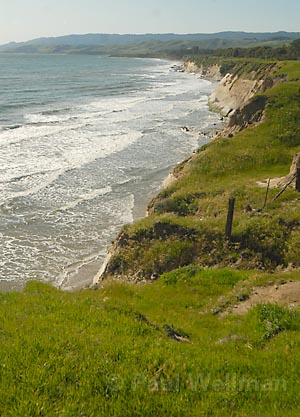The Summer of Naples
County Approval Process Heats Up for Beloved, Beleaguered Gaviota Coast Property

Above: Naples owner Matt Osgood (right) and Santa Barbara County planner Tom Figg talk during a break in the proceedings.
And the beat goes on. With relatively little fanfare, the battle over the fate of Naples, that idyllic and historic slice of coastal heaven that sits at the easternmost gate of the Gaviota Coast, took some serious twists and turns last week as the Santa Barbara County Planning Commission spent back-to-back marathon sessions trying to digest the controversial development project. With a re-circulated Environmental Impact Report (EIR) slated for public release sometime next week, commissioners enjoyed a lengthy sneak-peak at the soon-to-be-unveiled, several hundred-page document. This informational beast of burden was reconsidered and expanded after its predecessor document was deemed insufficient in 2006. Meanwhile, in a separate but related and perhaps ultimately much more significant matter, the commissioners worked to flesh out a Transfer of Development Rights (TDR) ordinance for the county.

It was decisions on the latter, on Thursday, June 5, that had opponents of the Naples development up in arms by week’s end, their hopes dashed, at least for now, that a healthy TDR program might be able to scale back the proposal to build 72 large-scale luxury homes on the Gaviota. A clearly frustrated attorney Nathan Alley of the Environmental Defense Center, which represents the Surfrider Foundation in the fight against a McMansion invasion, summed up the commissioners’ rulings on Friday morning, “Right now, we are left with a TDR that is basically going to be worthless. They screwed it up to the point where there is really no value to it at all.”
Looking to resolve a debate sparked more than two decades ago by a now infamous bit of Naples-specific coastal land use policy, the county began, in 2006, to investigate the possibility of establishing a TDR as means of reducing any would-be development of the Naples property. A complex dance of money, building rights, and urban density that essentially transfers some of the rights to develop a rural area like Naples to a more urban place like downtown Santa Barbara, while compensating all developers involved, a TDR ordinance was finally given a 4-0 vote of conceptual support from the Santa Barbara County supervisors this past winter.
With that vote, the county planning department started working overtime to try and craft what exactly that ordinance would look like, the hope being that they could create a workable plan in time for it to be a part of the final Naples decision. To that end, the Planning Commission first heard back from staff in early May only to punt the issue, in the name of still more research, until last week.

While that TDR talk once again resulted in a punt – the debate will begin anew on July 23 – the commission did arrive at some key decisions, specifically that any receiver site of a TDR trade would have to come from an already established urban South County neighborhood and, much more significantly, that urban developers wishing to increase the density of their projects, via an upzone or rezone, would not be required to use a TDR program as means to that end. This switch from a mandatory to a voluntary type of program is a major blow to those who are counting on the TDR to become a helpful tool in the fight for land preservation–not just at Naples but countywide. As enviro lawyer Marc Chytilo, who is representing the anti-development Naples Coalition, put it bluntly, “They’re just blowing it.”
To Chytilo and Alley, the key to a successful TDR program is securing the participation of both seller and buyer. That is to say, in the case of Naples, the intent would be to give Orange County developer Matt Osgood – who actually bankrolled the county’s initial study of a TDR ordinance and has since paid heavy lip service in support of such a program – an incentive to trade away some of his development rights, at the same time incentivizing urban developers to pony up, by paying into a TDR bank, in exchange for permission to increase their project’s density. The funds in the TDR bank would be used to buy-down proposed developments in rural areas. From the get-go, the county has shied away from making the program mandatory for Osgood. However, county staff and the Board of Supervisors had, at least to a degree, been receptive to making up-zones and rezones for future urban developments only possible if the proposals entered into the TDR process.
But all that changed on Wednesday when, perhaps fearing that such a rule would result in widespread rezoning efforts, the planning commissioners, save for the 1st District’s Mike Cooney, decided to pursue a bonus density model in which would-be urban developers could apply for a re-zone regardless of any TDR process and, once that was complete, could choose to pay into the TDR bank if they wished to add density on top of what the rezone had given them. (For example, if rezone granted a project 10 units, then a developer could pay a set rate TDR rate for each additional unit–or upzone–on top of that). Summing up what this means for the TDR bank, the financial health of which is penultimate for a successful program, Chytilo said, “Now the TDR will be sucking through the smallest straw possible instead of drinking through a firehose.” Add Thursday’s decisions to the long-standing determination to make Osgood’s participation voluntary, and you have the foundation for a TDR that establishes zero incentive for rural developers to sell credits, and at best a very vague incentive for urban developers to buy them.
While the commission is still far from sending a finalized version of the TDR ordinance on to the supes for final approval, it does appear that a crucial opportunity was lost this week. Even Commissioner Cooney opined, “It [the TDR] is now more voluntary than I think will work.” That being said, with the ins and outs of the bonus density component yet to be fully crystalized, the potential remains for some sort of better, more incentive-laden ordinance to emerge. In the meantime, the new EIR, complete with redoubled efforts to identify Chumash village sites on the property, and a whole new project option–known as “Alternative Prime”–that seeks to shuffle some of the homes proposed for the inland side of Highway 101 to more viewshed-friendly sites–is expected to hit the streets no later than June 13, with a sure-to-be-eventful public comment period to follow. Also, the Naples debate will be back at the Planning Commission on June 30, when a several-week-long phase-by-phase approval process for proposed Naples development is scheduled to begin, in hopes of paving the way for a possible date with the Board of Supervisors for final approval sometime this fall.
With his eyes on the daunting gauntlet of Naples-specific hearings this upcoming summer, Chytilo, in what was perhaps the understatement of the week, told commissioners late Thursday afternoon, “There are a lot of pieces to this puzzle that are still in the oven: I urge you to take your time.”



